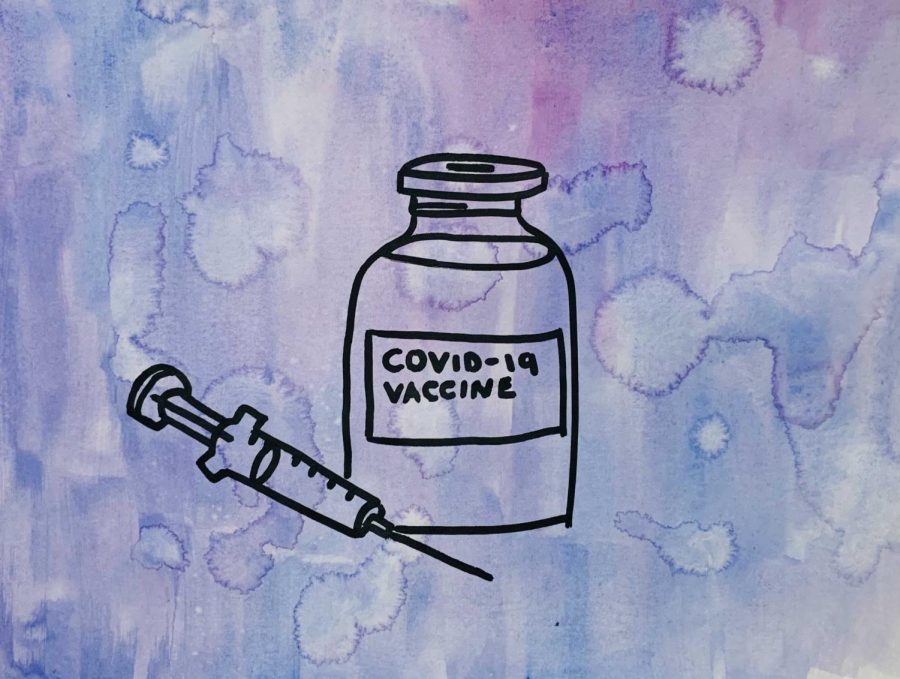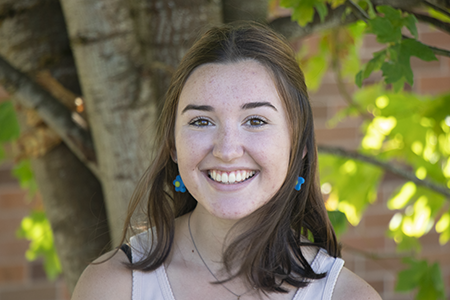Students Weigh In on the Approved COVID-19 Vaccines
“I do think it’s our ticket out of here eventually.”
The two vaccines in use have generated talk — of some concerns, some excitement, and some hopes for a future of pre-pandemic normalcy.
January 7, 2021
As they approach the end of a digital semester, students have been met with some hopeful news — the approval of two coronavirus vaccines.
The vaccines, one developed by Pfizer and BioNTech and the other by Moderna, have been authorized for emergency use by the Federal Drug Administration in the United States to help fight the coronavirus pandemic. Healthcare workers began receiving the first vaccinations on Dec. 14, which has continued as the virus death toll climbs past 350,000 lives across the nation.
“I’m feeling more optimistic that we’re going to return to normalcy,” junior Tyler Pham said. “But I mean, I think we’re not going to ever return to that for another few years because there are a lot of things that still need to progress.”
Freshman Amanda Folsom had similar thoughts — physically, she thinks normalcy may start to come back, but “in a social sense… we’re not going to trust each other as much, I don’t think,” she said.
The Pfizer-BioNTech vaccine was approved by the FDA on Dec. 11, allowing for the distribution of millions of doses across the country. Moderna’s vaccine was approved on Dec. 17, making it the first product from the company to have authorization of use from the FDA.
Although millions of doses are expected to get distributed in the U.S., healthcare workers, the elderly, and essential workers are prioritized as first recipients. Over five million people across the nation have already received the first dose.
In Oregon, there are about 350,000 people in the priority categories to receive the vaccine. After that, educators are among those next in line for the vaccine in the state, according to Gov. Kate Brown.
Senior Alex Fiedler said that he knows a “moderate amount” about the vaccines. “I think it’s pretty impressive scientifically, and in terms of production line, like how quickly they’ve managed to put everything together and get everything out,” he said.
He also noted that prisoners and inmates should be higher on the list of those who have access to the vaccines because of their circumstances in close quarters. Data shows that the virus has overwhelmed state and federal prisons, infecting one in five prisoners, a rate four times higher than that of the general population.
For Folsom, the rush of news has led her to have “complicated feelings about it.”
“I think it’s really good… it’s like the happy ending kind of, but it doesn’t feel amazing because I feel like it should be tested a little more maybe,” she said. “But also, the sooner the better… mostly I think it’s great, though.”
During testing, Pfizer’s vaccine trial included nearly 44,000 volunteers, and Moderna’s trial had 30,000. With over five million doses distributed so far, the only severe side effect has been that 29 individuals have suffered from severe allergic reactions, making the cases of anaphylaxis rare.
Senior Paige Martin said she feels the world is “starting to get ahead of itself a bit. Just because we’ve been quarantining since March and a vaccine is starting to come out doesn’t mean the pandemic is over,” she said. “We still have to stay safe and make smart decisions for a little while longer.”
Gov. Brown announced on Dec. 23 that Oregon schools can decide whether or not they will re-open starting Jan. 1., though students have varying levels of comfort. For Fiedler, an ideal scenario where students and staff have received both doses of the vaccine would put concerns at ease.
La Salle is currently in the process of considering a return to campus sometime second semester.
“At the start of the year I definitely thought we were going to be able to [go back to school], but now that it’s taken so long for the vaccine to get here, and that COVID numbers haven’t been getting better, they’ve been actually getting worse,” sophomore Thomas Olson said, “I don’t think it’s very likely. But I would love to.”
Both vaccines are similar in function, working through mRNA. The COVID-19 vaccines teach the body how to make a protein found on the coronavirus, prompting the immune system to attack it. Then, if the virus enters the body, cells will have learned how to fight this protein, and the immune system can recognize and attack it.
The vaccines also have similar efficacy rates, with Pfizer-BioNTech’s vaccine being 95% effective and Moderna’s being 94.1% effective. They are administered in two doses, though the time between doses varies between the two vaccines.
Because it requires two doses, it won’t be as effective until after the second dose. After receiving the vaccine, it is common that a person might feel fatigued or experience another COVID-like symptom for a short time after.
The potential for additional side effects is something of consideration for Olson. “I’m kind of just worried that there’s going to be some side effects that appear down the line that they’re not catching right now,” he said.
The biggest difference between Pfizer-BioNTech and Moderna’s vaccines is the environment they must be transported and stored in. Pfizer’s vaccine must be stored at extreme temperatures, so ultra-cold freezers along with dry ice are used. Moderna’s can be stored at less extreme temperatures, and is also shipped in smaller volumes — which means that Moderna’s vaccine will likely be distributed to rural areas and smaller hospitals that would have difficulties storing Pfizer’s vaccine correctly.
As for distributions, Fiedler said that he is a “bit nervous politically.”
Fiedler said that he had been reading about competition between rural and urban areas, and that the vaccines may end up going to places “that are able to pay more, and that’s unfortunate because rural areas tend to have older people with more underlying conditions, who need the vaccine more,” he said. “And that can also happen on a global scale with developed countries versus developing countries.”
Another problem within distribution is efficiency. In Oregon specifically, the number of vaccinations given in December fell short of the anticipated amount, though Gov. Brown has said that 12,000 doses administered per day is the goal in coming weeks in order to quickly get people vaccinated.
Neither vaccine has been approved for use in children. Moderna’s requires recipients to be at least 18 years old, and Pfizer’s is approved for those who are at least 16 years old.
Pham said that he doesn’t have many concerns around taking the vaccine, especially after public authorities have taken it, and Fiedler and Martin expressed similar ideas.
“I know people have concerns, but you know, all of the doctors that I know are saying that we should go get it,” Fiedler said. “I trust those people, and so I feel pretty confident in how the timeline has gone so far.”
Martin echoed this idea. “I don’t have any concerns,” she said. “I trust science, and the data that has come out so far has been promising.”
As for whether or not they would receive the vaccine if given the opportunity, all those interviewed said yes.
For Martin, she would take the vaccine to do her part in stopping the spread and protecting her loved ones, similar to Olson’s reasoning that the vaccine would make visiting extended family members safer.
Folsom said she would take the vaccine, even though she “wouldn’t be totally comfortable… I think it’s worth it,” she said.
The vaccines are not mandatory, and Folsom said that it should remain a person’s choice as to whether or not they will get vaccinated. “I wish everyone was comfortable with it, because then they can slow the spread,” she said. “But I mean, if you’re not, then you’re just not. And that kind of sucks.”
Fiedler had “mixed feelings” as well. He said that he thinks everyone should take the vaccine, but that it shouldn’t be mandatory. “I believe pretty strongly in bodily autonomy,” he said. “You should be able to choose what you do with your body medically.”
Pham analogized the nation as a net. “If one part of that net is weak, then I mean, we’re all going to kind of fall through,” he said. “We can’t have another outbreak among people who didn’t get the vaccine. And that halts progress around the nation.”
In general, the news of combatting COVID-19 with a new vaccine has been received with excitement by students. “I would say it’s made me more hopeful for the future,” Fiedler said. “Although, I do think there were… a lot of unfortunate failures on behalf of the government.”
“We can’t reverse [that] now,” Fiedler said. “But I am hopeful for the future.”






